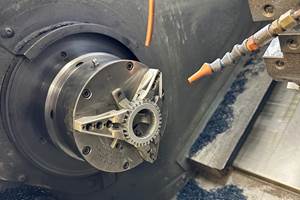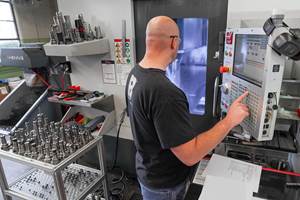PCD Tools Get Tough
Contrary to their reputation as tools reserved strictly for finish machining of non-ferrous metals, some polycrystalline diamond (PCD) cutting tools now possess the durability to handle a much wider range of applications.
Share





Contrary to their reputation as tools reserved strictly for finish machining of non-ferrous metals, some polycrystalline diamond (PCD) cutting tools now possess the durability to handle a much wider range of applications. As the utilization of aluminum-based parts continues to grow—particularly in automotive manufacturing—the performance of PCD tooling has become a more significant issue. In turn, this has produced strong, recent growth in the worldwide market for PCD tools.
Although cutting tools represent only a small percentage of the total cost to manufacture a specific part, the costs to interrupt production for frequent tool changes are substantial. Conventional PCD tools cannot withstand the wide variations in cutting force that are typical of rough-machining operations. Under these conditions, cutting edges chip readily, and tool consumption is unacceptably high. Chipping of the cutting edge commonly occurs during the initial stage of an interrupted machining process. As these chips accumulate, surface smoothness of the workpiece degrades and burring increases. For these reasons, cemented carbide tools are commonly used for milling and rough cutting of aluminum alloys.
The composition of conventional PCD tools derives from the sintering process by which they are manufactured. Because this process yields unbalanced distributions of diamond particles and a ferrous metal catalyst (primarily cobalt), an inverse relationship exists between wear resistance and strength in the tool. Coarse grades of PCD tools (containing larger diamond particles) are the most wear-resistant types, but they also have the least strength and toughness. Conversely, fine grades of PCD tools are very tough, but wear resistance is poor. Because of this performance trade-off, medium grades of conventional PCD tools are typically used to machine aluminum parts. But these tools can only provide median levels of toughness and wear-resistance.
To address these limitations, Sumitomo Electric Carbide, Inc. (Mt. Prospect, Illinois) has developed the Sumidia DA2200 line of high-strength PCD cutting tools. The proprietary manufacturing process for these tools produces uniform distribution of extremely fine diamond particles. This gives the tools a combination of substantial wear resistance and toughness (defined as “transverse rupture strength”). The result is a cutting edge with sufficient durability to handle rough and interrupted machining of various aluminum alloys and other non-ferrous metals.
Sumitomo has tested its new line of PCD tools under a variety of machining conditions. In milling and rough-cutting tests using an aluminum alloy workpiece, the performance of these tools is equivalent to cemented carbide tools. In continuous cutting tests, the DA2200 tools demonstrate wear resistance equivalent to conventional, medium-grade PCD tools.
Based on four typical machining applications for aluminum alloy parts, Sumitomo compared the performance of its improved PCD tools to conventional PCD and cemented carbide tools. In the facemilling of automotive cylinder heads, as well as endmilling of base plates for hard disk drives, the DA2200 tools demonstrated life spans up to three times longer than conventional PCD tools. When rough cutting a die-cast aluminum transmission component, the tools lasted approximately 20 times longer than cemented carbide. Additionally, when turning aluminum alloy wheels for autos, the tools delivered up to 17 times the life of conventional PCD tools. One of the nation’s largest automotive wheel manufacturers recently tested the tools independently and achieved 12-14 times the life of its existing PCD tools.
The improved inserts are available in a wide range of geometries and edge preparations for various applications. Inserts that incorporate WF-type edge preparation, for example, can produce mirror-like surface finishes. The tools are also available with reinforced K- and H-type edge preparations to bolster cutting edge strength during severely interrupted machining. These tools are suitable for machining aluminum alloys incorporating up to 18 percent silicon content.
Related Content
Chuck Jaws Achieve 77% Weight Reduction Through 3D Printing
Alpha Precision Group (APG) has developed an innovative workholding design for faster spindle speeds through sinter-based additive manufacturing.
Read MoreMedical Shop Performs Lights-Out Production in Five-Axes
Moving to five-axis machining enabled this shop to dramatically reduce setup time and increase lights-out capacity, but success relied on the right combination of workholding and automation.
Read MoreEight Articles to Understand Live Tooling
A roundup of the most read articles about live tooling on 91±¬ÁĎÍř.
Read MoreFive Common Mistakes Shops Make with ER Collets (And How to Prevent Them)
Collets play a crucial role in the machining process, so proper tool assembly and maintenance is important. Here are five potential pitfalls to avoid when using ER collets.
Read MoreRead Next
How I Made It: Dennis Rymanowski
Dennis Rymanowski has worked at NSH USA for 60 years, with his passion for manufacturing living alongside his passion for his family’s polka band.
Read MoreA New Frontier in Surface Finish Control
What if your machine tool could measure surface roughness as it cuts? This article explores how in-process metrology is advancing from concept to reality, enabling real-time feedback, immediate detection of anomalies and new levels of control over surface quality. Discover the technologies making this possible.
Read More





















